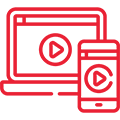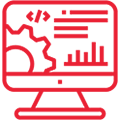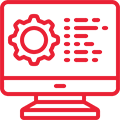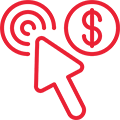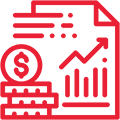“NEWMEDIA was by far the most economical and offered the best value for money. They built the whole site, including the add-ons, for under $30,000. We had other companies bidding up to $80,000.”
Programmatic Advertising Agency.
Interestingly, this marketing method expands beyond online advertising. Programmatic media buying is a recent phenomenon where programmatic platforms buy ad space on traditional media like TV.
Still, the bulk of programmatic advertising happens online. Here’s a chart from smartyads showing the growth of programmatic ads:
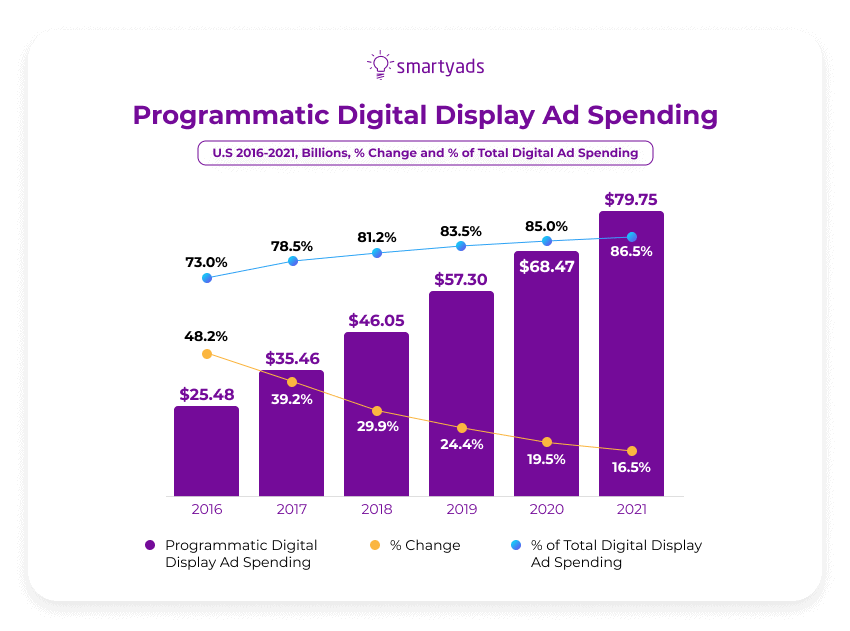
The details of the marketing process can be pretty complex, as is often the case with new technologies. That’s why many businesses struggle with running programmatic advertising campaigns without assistance.
Programmatic ad agencies are there to fill the gap, which is where NEWMEDIA comes in. If you don’t know how to design and launch programmatic campaigns, our digital agency will make the process trouble-free and seamless.
But first, let’s look at what programmatic ads are and how programmatic advertising platforms work.
Ad Buying Works
The simplest way to explain programmatic advertising is as an automated system of purchasing online ad space. Of course, that’s only the bare-bones definition.
As in traditional paid advertisements, programmatic ads have two interested parties: the advertiser and the publisher. The advertiser is looking for available ad space online, while the publisher sells that space on their website.
In programmatic advertising, these two sides don’t do business directly. The actual purchase happens through automated ad exchanges. Furthermore, advertisers and publishers aren’t the ones buying and selling – several programmatic platforms handle that process.
Each ad platform has a specific purpose in programmatic buying. Learning how these platforms operate will be essential for understanding the inner workings of programmatic advertising.
Marketing Director
Our expert digital marketing services increase your visibility, scale your ROI, and boost your bottom line.
Request a proposalSet SMART Goals
Three platform types form the backbone of programmatic advertising:
- Demand side platforms
- Supply side platforms
- Data management platforms
Supply and demand side platforms are directly involved in purchasing space for ads. We’ll delve deeper into those two platform types soon, explaining them in more detail.
A data management platform (DMP) works in the background. DMPs collect first, second, and third-party data about the target audience for a specific ad. The data may include traffic information from mobile devices, the potential customer’s online behavior, and even offline info.
Here’s a graphic explaining how DMPs work:
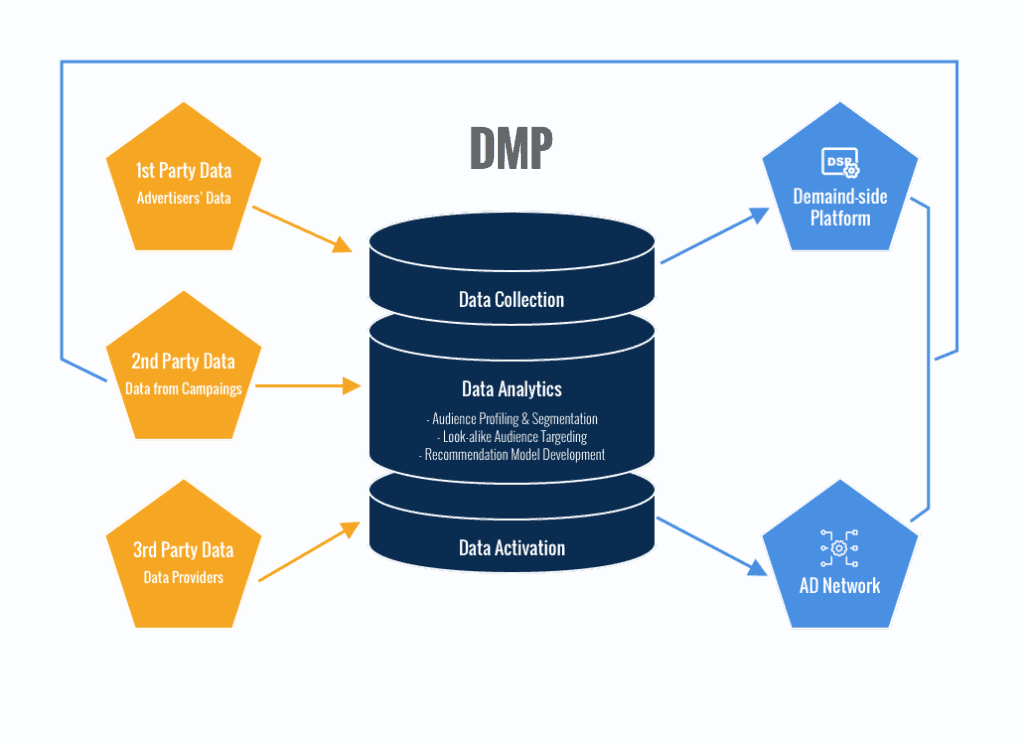
Essentially, a data management platform informs the direction of the purchasing process. It tells either side platform what steps to take to complete the transaction most efficiently.
Demand Side Platform
A demand side platform (DSP) purchases ad inventory on behalf of the advertiser. The platform performs several vital functions:
- Integrate with ad exchanges
- Determine the best opportunities
- Purchase ad inventory according to the pre-set budget
Ad exchange integration is a prerequisite for modern DSPs. Clients expect the demand side platform to work seamlessly with one or multiple ad exchanges. Naturally, leading DSPs always meet those requirements.
The DSP’s core components take care of finding and purchasing the best available ad inventory. The bidder is by far the most important component – it’s part of the DSP that actually buys the ad space.
Other parts of the DSP include the user interface, tracking databases, and reporting systems. A DSP can also have a dedicated server for ads, although many platforms use external servers for that purpose.
Better-known DSPs include Google AdWords and Microsoft Ads. The former works on Google’s ad network, while the latter services digital ecosystems like Bing, AOL, and Yahoo.
This illustration from Mediavine shows the basics of DSP:
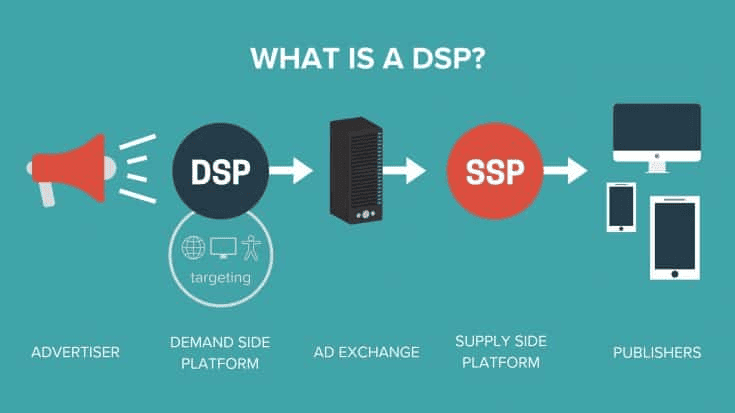
Supply Side Platform
A supply side platform (SSP) is a programmatic ad tech that publishers use to sell ads. The platform needs to perform several crucial functions to make the transaction seamless:
- Determine the optimal ad network
- Limit how many times to display the same ad to the same visitor
- Real-time bidding
The first step is possibly the most complex. The ad exchange may work with several networks, each with different conditions and requirements. The SSP must choose which network contains the best overall offers and sell the digital advertising space to that network.
Various factors play into how the SSP decides on a particular network. In particular, the platform looks into the offered price, latency, geographical suitability, and performance history.
Programmatic Buying Mechanism
Now that you know your DSPs and SSPs, we can explain what happens when you buy programmatic advertising.
It starts with the advertiser. A business purchases advertising services from a DSP. For example, you pay Google Ads to run a campaign. In most cases, the advertiser will supply their own material and specify ad formats, such as banner ads.
The DSP then connects to one or more networks. Since we’re using Google Ads as an example, it could connect to the Google Display Network.
The network integrates with a particular ad exchange. In our case, it will be the Google Ad Exchange. You can think of ad exchanges as virtual stock markets for ads.
The SSP connects to the available networks on the other end of the programmatic advertising line, choosing where to buy ad inventory. The publisher starts to serve ads as soon as the purchase is complete.
It’s worth noting that you buy ad inventory not per ad but per impression. In digital marketing, an impression is an engagement metric. It shows how many people interacted with your ad, which is a key component in campaign success.
You might know ad impressions under a different, more straightforward name: ad views.
See Our Portfolio
Molly Hall Dorais
Colorado Rocky Mountain School
Ready to grow your revenue? Just fill in the form, and let our experts take it from there.
Book a free consultationProgrammatic Advertising
With the basics of the programmatic ecosystem out of the way, it’s time to see what happens when you buy digital ads in programmatic marketing.
A professional programmatic ad agency should offer you four types of advertising separated into two groups. The groups are bidding and so-called programmatic direct.
Bidding is precisely what you think: multiple DSPs competing for digital display advertising, i.e., ads. On the other hand, programmatic direct means you’ll circumvent the bidding risks, and your ads will go directly to the publisher.
Bidding
Real-Time Bidding
Real-time bidding is the most common form of ad buying in programmatic advertising. It’s a public auction system with no participation limitations. All publishers and advertisers can throw their hats in through their DSPs and SSPs.
Think eBay, but for digital advertising.
It’s also massive, as this chart from The Business Insider shows:
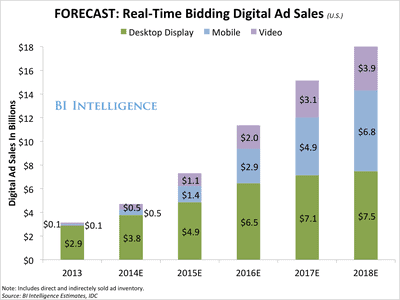
The real-time aspect is nothing short of impressive. The entire process happens between you clicking on a link and your browser loading the page. And to make things even more mind-blowing, the auction occurs each time a new visitor clicks the link.
As in regular auctions, bids start from the minimal offered price. The highest offer wins.
Real-time bidding eliminates the need for direct negotiations. It’s also a scalable way of programmatic advertising since you can simultaneously display advertising across numerous channels.
Bidding can be very cost-efficient. This is one of the primary benefits of programmatic advertising in general. Businesses with limited marketing budgets can still enjoy the advantages of digital marketing and reach their target audience.
On the flip side, this type of programmatic advertising can be somewhat uncertain. You won’t always know where your programmatic ads end up, and competitors may outbid you for the most appealing offers.
Private Marketplace
If real-time bidding is akin to eBay, private marketplace (PMP) bidding would be your Sothesby’s.
PMP functions much like real-time bidding, with one significant difference: the auctions aren’t open. Instead, publishers send invitations to select advertisers. Only those with invitations are allowed to join the marketplace and bid.
Each advertiser receives a unique time-sensitive ID and is only eligible for a particular auction. Once the auction starts, it plays out the same as the real-time variant. The participants bid, starting from the set floor price, and the highest bid wins.
PMP programmatic advertising auctions provide more control over the process. Both sides understand better what they’re getting out of the deal since these auctions are more transparent.
The selection of advertisers also means the ads will be shown to relevant customers. Of course, this is a benefit for the advertiser, as well as the publisher.
Unfortunately, PMP auctions are as crowded with competition as real-time ones. Neither publishers nor advertisers will have an easier time making programmatic advertising deals. Plus, the resulting ad campaigns may have reduced reach compared to other methods.
According to Mediapost, PMP is catching up to real-time:
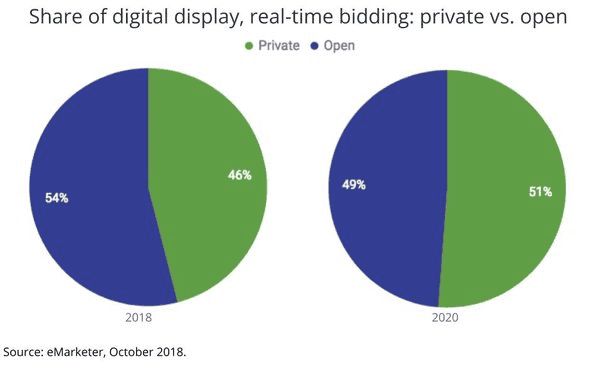
Direct
Guaranteed
Programmatic guaranteed is the most surefire way to get precisely the programmatic advertising you want. This model functions much the same as traditional marketing.
No bidding is involved in programmatic guaranteed. Instead, the two sides negotiate on the particular terms of the deal. This, of course, includes pricing and other terms, like, for instance, whether native ads are possible.
You may wonder what makes this method a part of programmatic advertising. After all, it sounds very similar to the old way of purchasing ads.
The answer is automation.
In traditional digital marketing, many advertising deal details need to be set manually:
- Ad tag exchange
- Billing oversight
- Insertion orders
- Troubleshooting
With guaranteed programmatic advertising, all these steps are automated. Plus, you don’t need to worry about the negotiations – a programmatic agency can handle that part.
Programmatic guaranteed offers more relevant ad placement and better overall quality. It’s also a safer way of media buying without the risk of ad fraud. However, this programmatic advertising type comes with steeper pricing.
Still, this chart shows it’s on the rise:
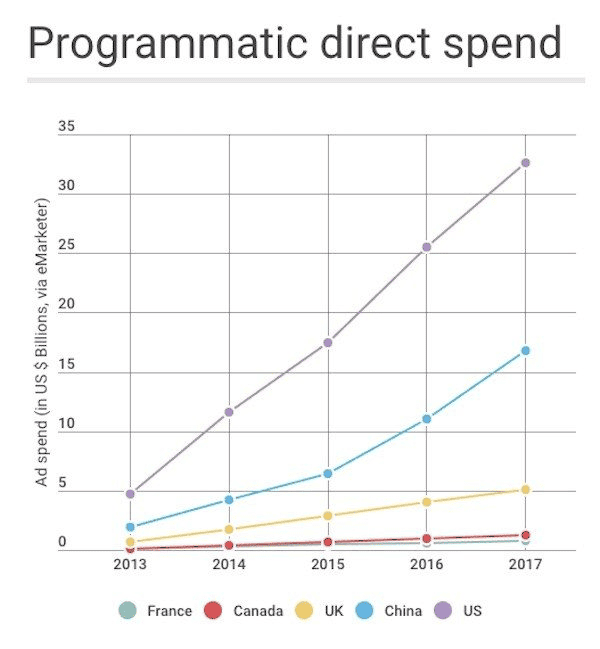
Preferred Deals
Preferred deals represent the middle ground between guaranteed and bidding variants. Here, the advertiser can opt to purchase. However, unlike guaranteed programmatic advertising, there’s no obligation to move forward with the deal, even after the two sides have come to terms.
Instead, the advertiser gets bidding priority. They can accept the offer, which gains them the space for ads, or decline it. In the latter case, the publisher takes the offer to an auction – either private or open.
Preferred deals are predictable, safe, relevant, and can be highly efficient. The downside is that publishers may have a hard time attracting advertisers unless the publisher can offer exceptional reach. Furthermore, the advertiser can opt-out at any given point, making the deal uncertain for the other side.
Programmatic Ads
The list of benefits of programmatic advertising is quite extensive. This digital marketing method represents more than a convenient option. Instead, it provides considerable advantages that range from superior return on investment to improved analytics.
Better ROI
Digital advertising has one primary purpose: driving conversions. If you want to capitalize on your total digital ad spend, those ads must bring in new clients. And programmatic advertising does just that.
Why?
You can keep tweaking your programmatic ads until they become ultra-efficient.
Programmatic advertising provides an opportunity for extensive A/B testing. You can run simultaneous campaigns with different types of ads on several platforms and see which variant performs the best.
As a result, choosing the optimal strategy becomes easier and faster. And optimized programmatic ads directly translate into higher conversion rates, i.e., better ROI:
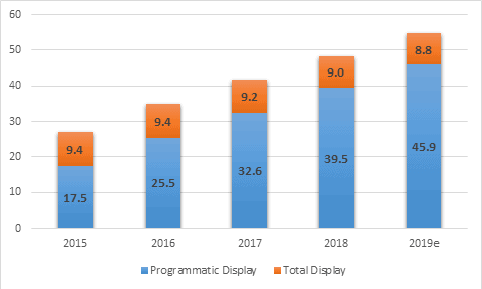
Increased Campaign Data Input
With programmatic advertising, you don’t need to rely on third-party data for in-depth analysis. Due to the digital nature of this marketing method, volumes of data will become available instantly.
You can see how well your campaign performs regarding various factors like ad type, demographics, user behavior, landing page efficiency, and more.
The information extracted from your programmatic advertising campaign will inform your future marketing efforts. In the long run, this will lead to improvements and a refined market approach.
Complete Campaign Control
Unlike other marketing methods, pay-per-click campaigns, in general, and programmatic advertising, in particular, offer full control over your marketing process.
This point will be more evident with a simple example.
Suppose you start a social media campaign on Facebook. That campaign may rely on the posts your business publishes on its official account.
This may sound like a great idea at first – free advertising, what’s not to like?
However, such marketing methods are susceptible to something you can’t control: user-generated content. Imagine that you decide to delete that Facebook post. It would disappear from your page but would remain everywhere on the site where other users shared it.
Programmatic advertising, especially programmatic guaranteed, gives you complete control over what you put into the market.
Real-Time Feedback
Programmatic advertising allows for nearly instantaneous feedback. In other words, you can see how your campaign performs almost as soon as it goes live.
With real-time click, impression, and conversion data, you’ll know if you’re on the right track immediately. This will also let you make the necessary adjustments and optimizations with minimal loss in time or profits.
Better yet, you can gain an understanding of which platforms work for your campaign or if you need to determine your target audience more precisely.
Having all that insight in real-time is invaluable. It can save your business months of experimenting and hindsight analysis. MarketingWeek reports that most businesses agree:
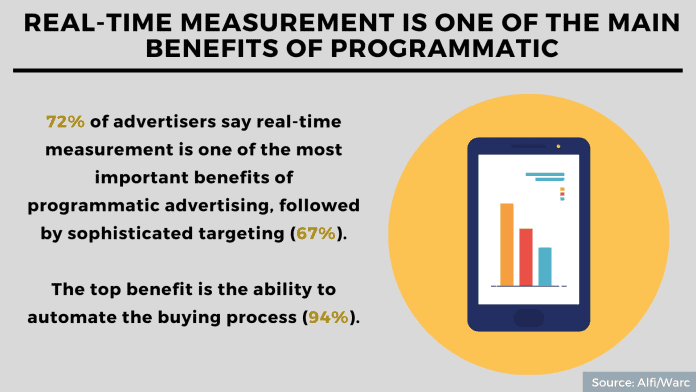
Pinpoint Programmatic Targeting
Programmatic advertising relies on detailed user data and a robust data management platform. It’s common sense that these factors influence marketing effectiveness, and that’s due to one simple fact:
Detailed data leads to more precise targeting.
Programmatic ads can reach not only your wider target audience but your ideal customers. By applying abundant user data, the system can place your ads in front of the people who need your products or services.
For example, if you start a programmatic advertising campaign through Google, you’ll have access to the expansive Google Display Network. With its unparalleled amount of user information, the network will easily serve your ads to the most fitting audience.
This benefit extends beyond new customers, too. Precise targeting means you’ll be able to build existing customers’ loyalty by presenting them with relevant, attractive new offers.
Cost-Effective and Scalable
As a type of pay-per-click advertisement, programmatic ads are cost-effective by nature. You pay whenever a potential customer clicks on your ad. In other words, you’re paying for each individual lead.
The common cost per click is about $2 and may go up to $4. This price doesn’t seem too steep, considering the potential gains upon conversion. In fact, if you have landing pages that convert reliably, programmatic advertising may seem downright cheap.
Another advantage is that you can set whatever budget you deem appropriate for your campaigns. Determine the maximum you’re willing to spend, and your campaign will never go over that point.
Similarly, if you need to upscale your marketing efforts, increasing the budgetary limit will be easy. With programmatic advertising, you’ll get what you pay for and often more.
Immediate Traffic Boost
Many businesses invest in organic traffic as a relatively inexpensive marketing method. However, achieving good organic results may take a long time – most often years before your brand hits the first page of Google search results.
Programmatic advertising (and PPC generally) gives you an instant boost in traffic. Due to pinpoint targeting, your campaign will start drawing in new visitors immediately. You can use that boost as a foundation while slowly building up your SEO for organic results.
Reaching Your Target Audience Everywhere
Traditional digital marketing requires you to devote attention to various platforms separately. You need to launch separate campaigns for Google, social media, and any other channel.
In contrast, programmatic advertising allows you to reach audiences on different platforms at the same time. If you translate that broad reach into actual numbers, you could have millions of leads across the internet in no time at all. Here’s what that looks like in graphic form:
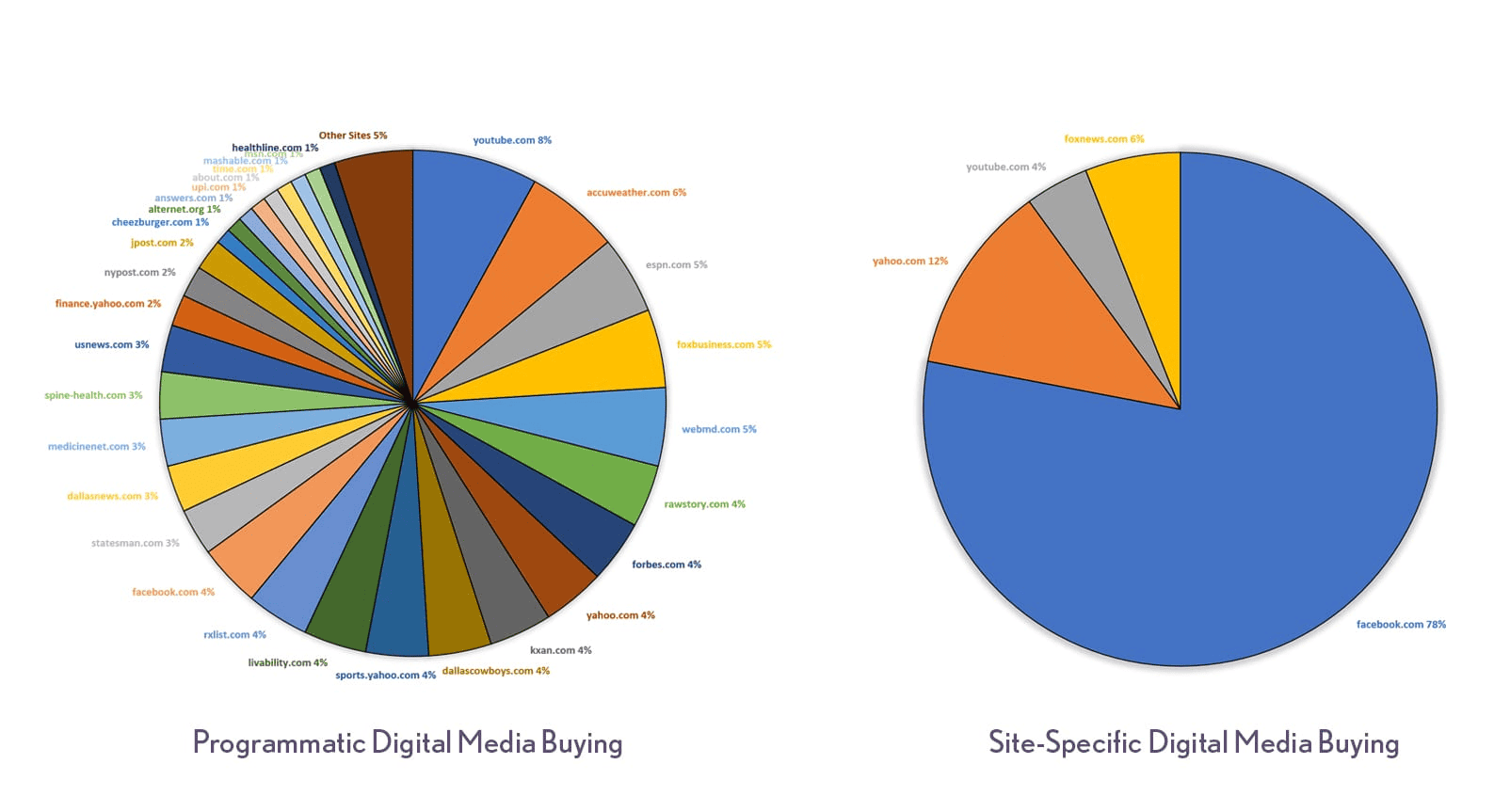
But suppose your conversion and sales funnels aren’t ready to make the most out of that reach. Even in that case, you’ll gain another advantage that may prove more worthwhile in the long run: brand recognition.
Whether you manage to turn new leads into customers, the fact is that more people will become aware of your business.
What Customers Say About Us
Randall T.
Scale your revenue online. Request a proposal now to receive a project blueprint, full pricing, and strategy.
Get my custom quoteHow Much Does Programmatic Advertising Cost?
The cost of programmatic advertising will depend on several factors. The stage of your business will be the first consideration. Startups will need more time to build an online presence and create brand awareness. Of course, this will translate into greater expenses.
On the other hand, an established company will likely need to spend less. An existing customer base is easier to build upon and reach.
Competition will be another crucial factor. Your ad spend will largely depend on how much your competitors invest in marketing. Plus, a very competitive environment will always demand higher investments.
We’ve already mentioned that the average cost per click is between $2 and $4. However, the total cost will be determined by the required scope of your marketing. Roughly speaking, your business could spend around 10% of its budget on marketing if you have a developed company.
The percentage is a bit staggering when it comes to new businesses. They’ll need to devote up to 20% of their budget. The good news is that programmatic advertising has excellent returns that should more than make up for the initial investment.
Launching More Effective Ad Campaigns With NEWMEDIA
The only way to make the most out of your programmatic advertising campaign is to entrust it to an agency that knows what it’s doing. And NEWMEDIA will be the ideal choice.
Our agency has been in the marketing business for more than 25 years. During that time, we’ve completed over 4,500 projects for 500+ satisfied customers and served more than 50 industries.
In other words, we know the marketing game in and out.
Here’s what NEWMEDIA can do for your business using programmatic advertising.
Foolproof Programmatic Advertising Strategy
With our strategy, consulting, and integration services, your campaigns will work flawlessly from the start. NEWMEDIA will do extensive research and analysis, starting from your brand purchase data. Then, we’ll deliver a comprehensive strategy that will take your business to the very top.
Detailed Market Analysis
NEWMEDIA analyses which keywords are most relevant in your market and applies them to your ads immediately. Better yet, our research allows us to apply negative keywords, i.e., those you don’t want to associate with your ads.
We’ll also look into what your competitors are doing (right and wrong) and design the optimal campaign for you based on extensive research data.
Creativity and Accuracy
Designing an ad isn’t as simple as people might think. You need exciting, creative ads to stand out in the highly competitive online environment. Plus, those ads must reach your brand’s target audience without exception.
NEWMEDIA’s creative department will design perfect ads for any platform. We’ll include effective copies with powerful words, enticing CTAs, and attractive imagery. As a result, your ads will be set to outperform the competition.
Testing and Adjustments
If you ask us when is the right time to stop testing a campaign, we’d say: never. Consistent tests lead to improvements, and that’s always NEWMEDIA’s focus.
We’ll continue to test for the most efficient formula, tweaking your message with advanced methods like dynamic creative optimization. Then, we’ll adjust your bids to account for underperforming factors and maximize your ROI.
Tracking and Detailed Reports
We’ve mentioned that programmatic advertising offers excellent conditions for real-time tracking. At NEWMEDIA, we use that opportunity to the maximum.
Our analytics team will consistently track crucial metrics like clicks and conversions. We’ll also keep a close eye on advanced metrics like sales attribution. Best of all, we’ll give you a detailed report about your campaign every week.
But you won’t receive only a sheet of numerical data. NEWMEDIA’s reports will include actionable, data-driven advice to recommend possible venues in decision-making.
Building Landing Pages That Convert
Finally, even the best, most thought-out programmatic advertising campaign won’t do much without a crisp, highly efficient landing page. Luckily, NEWMEDIA’s web development and web design teams are here to build you a killer landing page.
We’ll analyze your offer, target audience, and ad structure. Then, we’ll refine your landing page to correspond with your business goals and relate to your customers. Your new, relevant landing page will convert better and leave you with numerous satisfied customers.
Besides being a treat for visitors, an improved landing page will also do wonders for your ad quality score. This is a metric that impacts your entire campaign, from ad rankings to cost per click (CPC).
NEWMEDIA
If you’re ready to launch a highly-successful programmatic advertising campaign, start by getting in touch with NEWMEDIA. Our dedication to quality of service and extensive experience will make your ads efficient and cost-effective.
See firsthand why we ranked among the top 1% of global full-service agencies in digital advertising for the past three consecutive years. Contact NEWMEDIA and start conquering the digital marketing world.
Ready to scale your results? Connect with our team to get a custom digital marketing quote for your business.
Outrank my competitors

